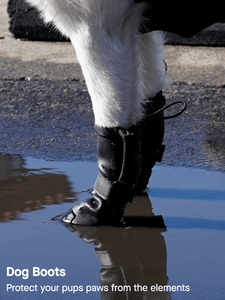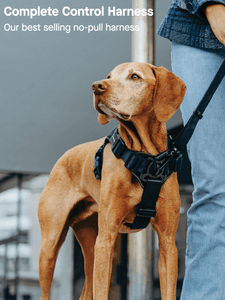Return to Blog
No-Pull Front-Clip vs. Back-Clip Harnesses: Choosing the Right Design
By Canada Pooch on Sep 6, 2023
No-pull dog harnesses have become a popular choice for dog parents who want to discourage pulling behavior during walks. But with so many different designs available, how do you know which one is right for your dog? In this article, we explore the different types of no-pull dog harnesses and provide tips on how to effectively use them. From understanding the concept of no-pull harnesses to analyzing the pros and cons of front-clip and back-clip designs, we'll help you make an informed decision. Let's dive in!
Understanding No-Pull Dog Harnesses
Investing in the correct walking equipment is important for any dog parent. A no-pull harness is popular for pet experts due to its dog-friendly design. The two most common types are the front-clip and the back-clip no-pull harness.
What Is a No-Pull Dog Harness?
A no-pull harness is one of the most valuable training accessories a pet parent can use to achieve leash walking success. Although frequently overlooked, implementing no-pull harness training can greatly improve a dog's manners and strengthen the bond between parent and pet.
Firstly, no-pull harnesses safeguard the physical wellbeing of both dog and human. When dogs yank on old-fashioned collars and leashes, it exerts unsafe pressure on their necks and spines. No-pull harnesses spread pressure over the chest and shoulders, avoiding throat squeezing. This diminishes the risk of neck and back injuries developing. Additionally, people often sustain arm, shoulder, and back wounds themselves from being jerked around by a pulling dog. No-pull harnesses diffuse strain and enable more controlled walking.
Improved Psychological Experience
Psychologically, no-pull harnesses also enhance the walking experience for dogs. No-pull harnesses promote calmness and safety. Dogs become less reactive and worried on walks as they link the harness with positive experiences. Their stress levels decrease.
For pet parents, no-pull harnesses restore freedom and direction during walks. The exhaustion of constantly wrestling a dog determined to sniff and sprint at the end of a tight leash is mentally and emotionally draining. Well-fitted no-pull harnesses allow people to relax and enjoy their surroundings too. Walks become shared adventures that strengthen the human-animal connection through improved communication, teamwork, and companionship.
Practical Training Benefits
Practically, no-pull harnesses instruct leash etiquette and obedience abilities. When paired with rewarding desired behaviors, they discourage pulling and lead dogs to heel more closely. Parents regain control and can safely take puppies to public places, knowing they will walk properly on leash without causing disruption. This expands opportunities for dogs to join parents in the community.
While no single tool can resolve all leash walking problems, no-pull harnesses remain one of the most helpful training aids. They offer a gentle, humane approach focused on communication rather than intimidation or discomfort. The physical and emotional perks for dogs and people make them an essential asset for promoting better walks, improving conduct, and deepening the animal-human relationship. Their ability to transform turbulent pulling into peaceful walking makes no-pull harnesses a worthwhile investment for all pet parents struggling with leash walking.
Analyzing Front-Clip No-Pull Harnesses
The Design of Front-Clip No-Pull Harnesses
The front-clip no-pull harness has a leash attachment point on the dog's chest area. This design gives you more control over your pooch's direction, making it perfect for teaching your pup how to walk properly. However, the front-clip design might not be suitable for every dog, and it can sometimes get tangled between the dog's legs.
Pros and Cons of Front-Clip No-Pull Harnesses
On one hand, front-clip no-pull dog harnesses are great for training purposes, and they provide excellent control over your pet’s walking direction. However, they might not be the best choice for highly active dogs, as the leash can get tangled easily.
For optimal use of no-pull harnesses, consult with pet experts or do some thorough research to assess the best walking equipment for your pup.
Evaluating Back-Clip No-Pull Harnesses
The back-clip no-pull harness is a popular option among dog parents for its ease of use and good control. This type of harness features a clip that is located on the back (usually between the dog's shoulder blades) which allows a leash to be securely attached.
Design of Back-Clip No-Pull Harnesses
Pet experts appreciate the intricate design of the back-clip dog harness. They are designed to evenly distribute the force when a dog pulls, preventing pain or potential injury. Additionally, they provide better management and control, especially during outdoor activities.
Advantages and Disadvantages of Back-Clip No-Pull Harnesses
The design of a back-clip dog harness offers several advantages and disadvantages. They're great for dogs who don't pull excessively or have health issues like a delicate neck.
However, a back-clip harness may not work if your pup pulls too robustly. Some dogs might become more excited and pull more when feeling the pressure on their chest and back. Therefore, a back-clip harness is not always the optimal choice for dogs who exhibit intense pulling behaviors.
Tips for Effectively Using No-Pull Dog Harnesses
Correctly Measuring Your Dog for a Harness
Before purchasing a harness, it's vital to measure your dog correctly.
Measurements should include the circumference around the widest part of the chest and the narrowest part of the neck. Consider the breed size and weight too, as this information often helps in the accurate sizing of the harness.
It’s important to note that a well-fitted harness is essential for your dog's comfort and safety.
Remember to check the tightness of the dog harness frequently, as a loose harness could slip off, and an overly tight one may lead to discomfort or injury. Reference our size guide to find the right fit for your pup.
Properly Putting on a No-Pull Harness
Now that you've chosen your preferred No-Pull harness and taken the necessary measurements, it's time to dress your pooch correctly.
Place your dog’s legs through the appropriate loops, usually one on either side of the dog's body. Pull it up onto your dog’s back and buckle it up, making sure it fits comfortably. Double-check the position of the harness too. The front clip should rest on the dog's chest, and a back clip should reside on its back.
Many dog parents dread the process of tightening the harness. However, a properly adjusted harness can significantly improve your outdoor activities with your beloved pet.
While harnesses are very useful training tools, they may not solve every pulling issue. Consistency, positive reinforcement, and additional obedience work will likely be required to fully curb pulling habits. But by selecting the no-pull harness design best suited to your dog and using it properly, you’ll be off to a great start in making your walks more peaceful and enjoyable. With the right combination of equipment and training, you can transform those pulls into polite walks and strengthen your bond in the process.


